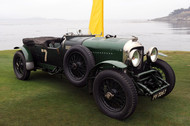The Evolution of Automotive Performance: A Journey Through Time with Extreme Power House
18th Apr 2023

From the earliest days of the automobile to the high-performance machines we see today, the evolution of automotive performance has been a fascinating journey. At Extreme Power House, we have always been passionate about the vehicles that push the boundaries of speed, power, and handling. In this blog post, we will take a deep dive into the history of performance cars, examining the groundbreaking innovations and key milestones that have shaped the industry.
The Dawn of Performance Cars:
The early 20th century saw the birth of the automobile, with manufacturers like Ford, Cadillac, and Mercedes-Benz leading the way. As cars became more widespread, there was a growing desire for vehicles that offered not only utility but also excitement and enjoyment. This led to the development of the first true performance cars, such as the 1910 Mercer Raceabout and the 1912 Stutz Bearcat. These early speedsters prioritized lightweight construction and powerful engines, setting the stage for the performance cars we know today.
Post-War Speed and Muscle:
Following World War II, the automotive industry experienced a boom, with manufacturers pushing the limits of what cars could do. In the United States, the muscle car era began in the late 1950s, with cars like the Chevrolet Impala SS and the Ford Thunderbird. These vehicles featured powerful V8 engines and an emphasis on straight-line speed, capturing the hearts of enthusiasts nationwide.
Across the pond, European manufacturers such as Ferrari, Porsche, and Jaguar were developing high-performance sports cars that prioritized both speed and handling. Iconic models like the Jaguar E-Type, Porsche 911, and Ferrari 250 GTO emerged during this time, solidifying their place in automotive history.
The Turbocharger Revolution:
As automotive technology advanced, manufacturers began to experiment with new ways to increase power without sacrificing efficiency. One such innovation was the turbocharger, which first gained prominence in the 1960s and 1970s. By forcing more air into the engine, turbochargers allowed for greater power output while maintaining a relatively small engine size. This technology proved pivotal in the development of modern performance cars, including iconic models such as the Porsche 930 Turbo and the BMW 2002 Turbo.
The Rise of Electronics and Computerization:
The 1980s and 1990s saw rapid advancements in automotive electronics, with computerized engine management systems, fuel injection, and advanced traction control becoming increasingly common. This period also saw the rise of Japanese performance cars like the Toyota Supra, Nissan Skyline GT-R, and Mazda RX-7. These vehicles combined cutting-edge technology with powerful engines, earning a reputation for performance and reliability that still endures today.
The Modern Performance Renaissance:
In recent years, the automotive performance landscape has evolved yet again, with a renewed emphasis on efficiency, sustainability, and technological innovation. The rise of electric and hybrid vehicles, such as the Tesla Model S and the BMW i8, has demonstrated that performance and environmental responsibility can go hand in hand.
At the same time, traditional performance cars have continued to push the limits of what is possible, with supercars like the Bugatti Chiron and the Koenigsegg Jesko showcasing mind-blowing speed and power.
Conclusion:
The evolution of automotive performance has been a story of constant innovation, driven by a passion for speed, power, and excitement. At Extreme Power House, we are proud to be a part of this ongoing journey, providing enthusiasts with the performance parts and expertise they need to keep pushing the boundaries. As we look to the future, we eagerly anticipate the next chapter in this incredible story and can't wait to see what the world of automotive performance has in store.

